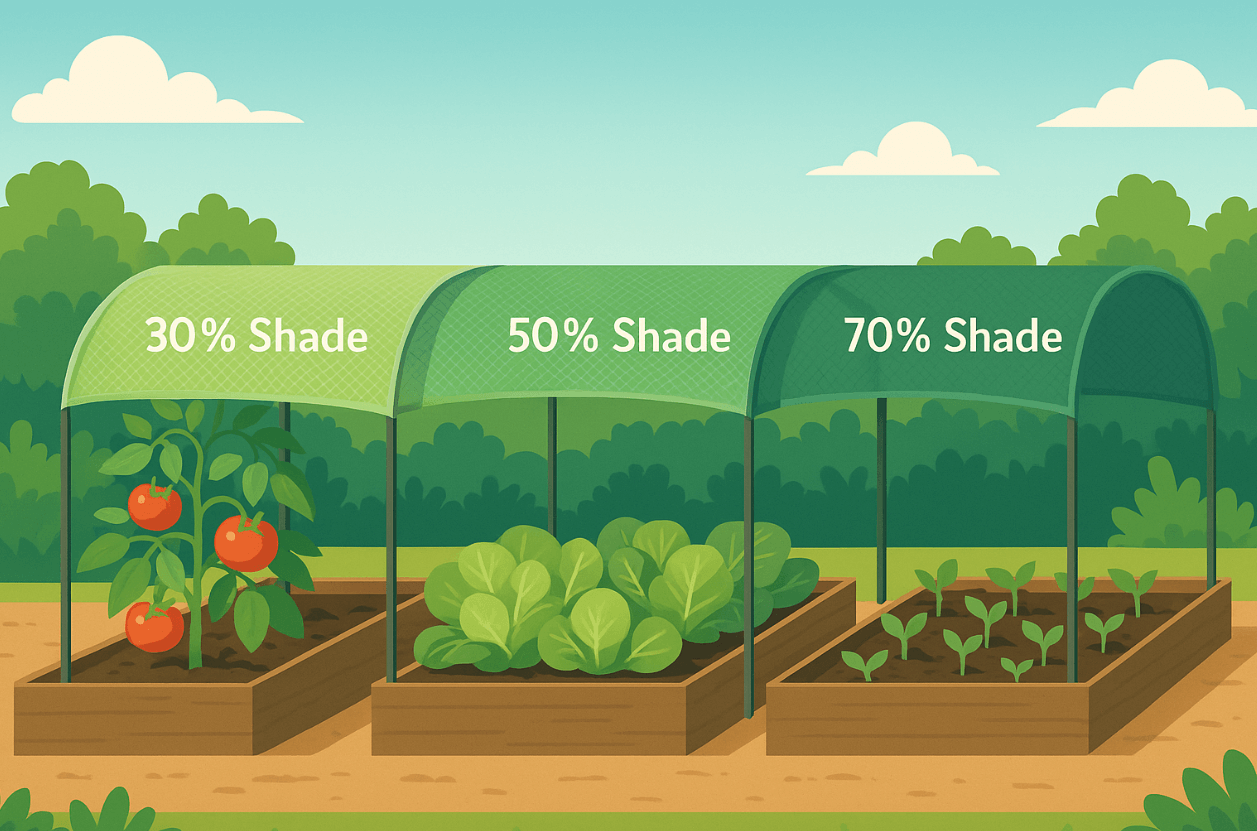What Percentage Shade Cloth for Garden? A Quick Guide
Your plants thrive on sunlight—right up until the moment they don’t. Too much midday radiation can bleach leaves, stall growth, and push soil temperatures above root‑safe levels. That’s where knowing what percentage shade cloth for garden success really means. The “percentage” tells you how much sunlight is blocked, creating a gentler microclimate that protects crops without starving them of the light they need to photosynthesize. Wellco Wholesale—your factory‑direct source for agricultural and landscaping supplies—stocks shade cloth from 20 % to 90 % to match virtually every growing scenario.

Understanding Shade Cloth Percentages
How Percentages Are Calculated
Manufacturers test cloth under full sun and record the share of light it stops. If 50 % is blocked, the fabric carries a 50 % shade rating. Because knitted high‑density polyethylene (HDPE) scatters rather than simply blocks rays, a 50 % cloth still transmits useful diffuse light.
Light, Heat & Plant Physiology Basics
Photosynthesis peaks at specific light intensities and leaf temperatures. A University of Arizona extension study found lettuce yields climbed 14 % when afternoon leaf temperatures were lowered by 5 °C using 50 % shade cloth. Plants also transpired 10 % less water—proof that the right shade percentage balances light capture and heat relief.
Key Factors in Selecting the Right Percentage
Crop Type & Growth Stage
-
Leafy greens and herbs: thrive at 30 %–50 % during hot spells.
-
Fruiting vegetables: tomatoes and peppers may start under 40 % and step up to 30 % as fruit sets.
-
Seedlings: tender cotyledons scorch easily, so 50 %–70 % shield is common the first three weeks.
Regional Climate & Season Length
Growers in Phoenix’s 110 °F summers lean on 50 %–60 % cloth, while coastal Oregon gardeners often top out at 30 %. Short growing seasons benefit from lighter shade to avoid slowing maturity.
Garden Layout & Existing Structures
Hoop houses and greenhouses trap heat; adding 20 %–30 % internal shade can keep daytime highs under 90 °F without venting 24/7. Open beds may need a stronger panel but only for June‑August.
Recommended Percentages for Popular Crops
Vegetables & Herbs (30 %–50 %)
| Crop | Ideal Shade % | Tip |
|---|---|---|
| Lettuce, spinach | 40 %–50 % | Lift cloth 18 in above canopy for airflow. |
| Tomatoes | 30 %–40 % | Remove once daytime temps drop below 88 °F. |
| Basil | 40 %–50 % | Prevents leaf scorch and volatile‑oil loss. |
Fruits & Berries (20 %–40 %)
Strawberries favor 30 % cloth during flowering; blueberries in hot zones can remain under 35 % all summer to deter sunscald.
Ornamentals & Seedlings (50 %–70 %)
Orchids often grow under 60 % lattices in commercial houses. Nursery trays stay under 55 % until roots fully knit.
Installation & Maintenance Best Practices
Correct Orientation & Airflow
Run panels north‑south so the sun tracks across the weave, reducing morning–afternoon hot spots. Maintain at least 6 in between cloth and foliage to vent hot air.
Secure Fixings, Tension & Edge Reinforcement
Stainless grommets every 18 in, batten tape along raw edges, and UV‑rated zip ties double lifespan compared with improvised string.
Cleaning, Storage & UV Degradation Checks
A mild detergent rinse each fall stops algae that can cut light further. Fold only when dry, store above freezing, and inspect for brittle threads after year five; knitted HDPE from Wellco Wholesale carries a 7‑year UV warranty.
Case Study: 50 % Knitted Cloth in a California Lettuce Tunnel
Baseline Sunburn Losses vs. Post‑Install Yields
A 2‑acre Salinas Valley farm reported 17 % sunburn culls at peak July heat. After installing 50 % knitted panels, culls fell to 4 %, and marketable weight per box jumped 12 %.
Grower Quote on Quality & Ease of Use
“The 50 % knit kept leaf temps steady without stunting growth—we rolled it out once and left it all season,” notes the farm’s operations manager.
Sourcing & Purchasing Tips
Fabric Types, GSM & UV Warranty Explained
Knitted HDPE resists fray, while woven PP offers razor‑straight edges for greenhouse screens. Compare grams per square meter (GSM): heavier cloth delivers tighter shade and longer wear. Always check for at least a 5‑year UV warranty.
Bulk Savings & Custom Cuts with Wellco Wholesale
Because Wellco ships direct from the mill, trade customers enjoy price breaks on full 6.2‑ft × 328‑ft rolls, but hobbyists can still order custom‑cut panels to the nearest foot. Request free swatches to test light quality before committing.
Conclusion
Choosing what percentage shade cloth for garden success boils down to crop needs, climate, and structure. Start with the guidelines above, then fine‑tune by monitoring canopy temperature and leaf color. Ready to protect your yields? Reach out to Wellco Wholesale for tailored advice, free samples, or an instant quote—your plants (and customers) will thank you.
Frequently Asked Questions
Q1. How do I calculate the shade percentage I actually need?
Measure midday leaf temperatures for a week; if they exceed optimal ranges by more than 5 °F, step up to the next shade tier (e.g., 30 % → 40 %).
Q2. Will a single cloth work for both seedlings and mature plants?
Yes—install a 50 % cloth for seedlings and raise it several inches or replace with 30 % once plants harden off.
Q3. How long does HDPE shade cloth last outdoors?
Quality knitted HDPE with UV inhibitors typically delivers 7–10 seasons before significant brittleness appears.
Q4. Can I get custom sizes for an irregular greenhouse roof?
Wellco Wholesale offers cut‑to‑length service and edge reinforcement, so you can match any frame without extra trimming.
Q5. Does shade cloth reduce wind damage?
It moderates gusts by 10 %–30 % depending on weave, helping prevent snapped stems in exposed gardens.
